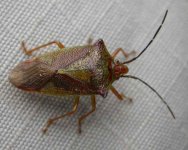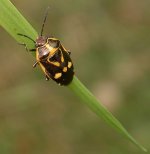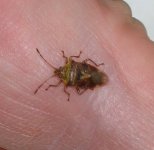Hello Colin, :hi:
No, there aren't any aquatic Shieldbugs, they are all terrestrial or arborial. However, there is a large range of aquatic bugs which are very interesting in their own right. They include several species of Pond Skaters, and a couple of Water Measurers which occupy the surface of the water.
Beneath the surface there are Water Scorpions, numerous 'Corixid's' and other larger 'Back Swimmers' sometimes referred to as Water Boatmen. They are a fascinating group to study and record, unfortunately, they are a much neglected group.
There are very few books available on their identification, and what is available, tends to be rather expensive. The Land and Water Bugs of the British Isles by Southwood and Leston 1959, is perhaps one of the best, but it is out of print, and second-hand copies retail for £130.00 + although a CD-ROM of this book is available from Pisces Conservation at about £55.00. You may be able to obtain an original copy through one of the book dealers on:-
http://www.abebooks.com/
or on eBay, where they occasionally show up from time to time.
I'm afraid I cannot identify your 'bug' from your description, but it sounds as if it may be one of the four species of Water Boatmen.
Please do encourage your grandchildren to have an interest in nature, there are so few newcomers entering the field of natural history. I am often dismayed to find, that when I give lectures to natural history societies that I am the youngest person present, and I am in my early sixties. :storm:
Edit. There is a second hand copy of the CD-ROM available on abebooks.com from Pemberley Books at £20. if you are interested.
Harry







